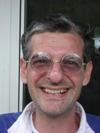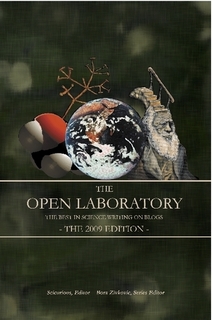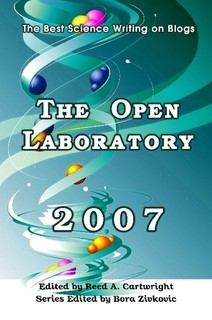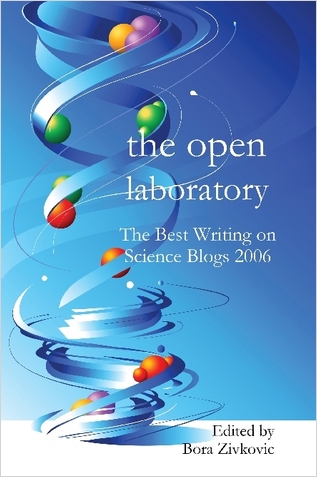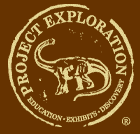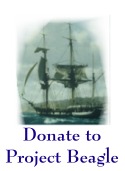Continuing with the tradition from last two years, I will occasionally post interviews with some of the participants of the ScienceOnline2010 conference that was held in the Research Triangle Park, NC back in January. See all the interviews in this series here. You can check out previous years' interviews as well: 2008 and 2009.
Today, I asked Andy Farke from the Raymond M. Alf Museum of Paleontology in Claremont, CA to answer a few questions.
Welcome to A Blog Around The Clock. Would you, please, tell my readers a little bit more about yourself? Where are you coming from (both geographically and philosophically)? What is your (scientific) background?
I grew up in rural South Dakota, with a high school graduating class of only 16 students. From a very young age, I had always been fascinated by paleontology (the study of past life, including dinosaurs). Because I didn't know any better, I started writing to paleontologists whose names I found in some of my books, asking for assistance with little research projects that I had devised. One thing led to another, and the next thing I knew I was competing (and placing) in the Intel Science and Engineering Fair. (I feel just a twinge of personal pride over this, because I did rather well despite lacking access to the large research university labs and formal school programs that so many of my competitors had!) One of these projects led directly to my Ph.D. work at Stony Brook University, which I finished in 2008. Today, I'm a curator at Raymond M. Alf Museum of Paleontology in Claremont, California. Not only do I work as a researcher, but I'm also fortunate in that our museum is partnered with a high school (The Webb Schools), and many of the students from there are quite active in our museum's research, outreach, and other activities. Because of my own experiences, I'm firmly convinced that science can be done by anyone, and that science should be accessible to everyone.
Tell us a little more about your career trajectory so far: interesting projects past and present?
A good portion of my career (indeed, beginning in high school) has been devoted to understanding the horned dinosaurs (Triceratops and their relatives). I'm particularly interested in how their massive skulls, measuring up to 3 meters in total length, functioned. Horned dinosaurs are odd, in that they have giant sinuses beneath the horns. Some researchers had speculated these sinuses functioned as shock absorbers during horn-to-horn combat, based on the observation that bighorn sheep and other modern horned animals also have big sinuses in their skulls. It turns out that we really don't understand the sinuses even in modern animals - so many of my research efforts have focused on unraveling this problem. Other research projects have included describing and interpreting the evolutionary relationships of some new species of horned dinosaurs, paleopathology (the study of injury and disease in the fossil record), and the paleontology of Madagascar.
What is taking up the most of your time and passion these days? What are your goals?
Right now, I'm working on advancing open science in my own field of paleontology. Open access publishing is certainly a part of this - I'm a volunteer section editor for paleontology at PLoS ONE. Paleontology is a science that relies heavily on lengthy descriptions and quality illustrations - but recent trends in science publishing mean that more and more of the "good stuff" is either consigned to effectively invisible supplemental information or just not published at all. It's my hope that not only will electronic publications like PLoS ONE and Palaeontologia Electronica increase the exposure of our research, but that they will improve the quality of our research by allowing paleontologists to publish complete, well-illustrated descriptions of specimens from the start. Second, I'm a firm proponent of increasing data sharing and transparency. The vast majority of quantitative studies in paleontology quite frankly aren't reproducible - the numbers behind the statistics are locked up on someone's hard drive. With the ease of including supplemental information or depositing data in online archives, there is simply no excuse for this situation. So, I (along with several colleagues) am working on changing this attitude in our field.
What aspect of science communication and/or particular use of the Web in science interests you the most?
I think it's really cool that it's so easy to connect scientists with other scientists, and scientists with interested members of the general public. That's part of the reason why Matt Wedel, Mike Taylor, and I founded the Open Dinosaur Project. In short, this project allows anyone with an internet connection (regardless of education, profession, or geographic location) to participate in dinosaur science. Our volunteers are helping us to amass a giant database of dinosaur limb bone measurements from the literature and museum specimens, which we're analyzing to understand the evolution of dinosaur locomotion. Every aspect of the project is open - from data collection to publication. Our volunteers provide measurements, suggest analytical approaches, and much more. Most of the participants will be co-authors on the resulting paper!
How does (if it does) blogging figure in your work? How about social networks, e.g., Twitter, FriendFeed and Facebook? Do you find all this online activity to be a net positive (or even a necessity) in what you do?
I blog at The Open Source Paleontologist as well as The Open Dinosaur Project. Through these blogs, I trade research techniques and philosophies with colleagues and try to advance the case for open science within our discipline. Blogging has been a great way to meet other researchers, developing friendships and collaborations that wouldn't have happened otherwise. Facebook in particular is most widely used in paleo, and it's proven to be useful for keeping up with everyone else's research activities. There's no doubt that all of this online activity is a huge positive.
When and how did you first discover science blogs? What are some of your favourites? Have you discovered any cool science blogs by the participants at the Conference?
I can honestly say that my earliest exposure to science blogs was through A Blog Around the Clock, and my reading list has ballooned since then. Among others, I always look forward to updates on Dave Hone's Archosaur Musings, Sauropod Vertebra Picture of the Week, and Save Your Breath For Running Ponies (the funniest science blog, period). From ScienceOnline2010, I was happy to discover the blogs of Cameron Neylon, Jean-Claude Bradley, and Dorothea Salo, among others.
What was the best aspect of ScienceOnline2010 for you? Any suggestions for next year? Is there anything that happened at this Conference - a session, something someone said or did or wrote - that will change the way you think about science communication, or something that you will take with you to your job, blog-reading and blog-writing?
My favorite part of ScienceOnline was getting to meet so many folks I had only heard of or communicated with through the Internet - people like Pete Binfield and Janet Stemwedel. Even better were those unexpected meetings with so many other open science advocates. I left the conference energized and excited about carrying on the push for open science!
It was so nice to see you again and thank you for the interview. I hope to see you again next January.

